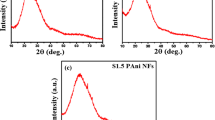Abstract
Conducting Polyaniline films (Pani) on Corning glass substrates, produced using either an in-situ doping process or a co-doping process, were prepared by the oxidative polymerization of aniline in N,N,dimethylformamide. Bicyclic aliphatic camphorsulfonic acid (CSA), aromatic toluenesulfonic acid (TSA) and carboxylic trifluoroacetic acid (TFA) were employed as doping agents, and CSA mixed with TSA and CSA mixed with TFA were employed as the co-doping materials. The topography of the Pani films was analyzed by atomic-force microscopy (AFM), and their doping and oxidizing states were characterized by Fourier-transform infrared (FT-IR) spectroscopy and optical (UV-Vis) spectroscopy. Flower-like clusters, microfibers, and nanofibers were obtained by doping with CSA, TSA, and the mix of both (CSATSA), respectively. The flower-like morphology limits the conductivity of the film while the microfiber morphology leads to a highly conductive film. The conductivity of the films increases with the doping level, coil-like conformation of the chain and the protonation of the imine in quinoid units. The codoped process reduces the roughness of the CSA-doped films by 50%, but the conductivity depends on the acid type used for this process (TSA or TFA). The optical gas sensor response of the films is related to both the morphology and the degree of protonation. In this study, Pani with a microfiber morphology obtained from TSA-doping is the most sensitive to ammonia gas sensing, and Pani with flower-like morphology is the least sensitive.







Similar content being viewed by others
References
H. Hu, M. Trejo, M.E. Nicho, J.M. Saniger, A. García-Valenzuela, Adsorption kinetics of optochemical NH3 gas sensing with semiconductor polyaniline films. Sens. Actuators B 82, 14 (2002)
J. Elizalde-Torres, H. Hu, A. García-Valenzuela, NO2-induced optical absorbance changes in semiconductor polyaniline thin films. Sens. Actuators B 98, 218 (2004)
H. Hu, B.E. Ortíz-Aguilar, L. Hechavarría, Effect of pH value of poly(ethylenimine)-H2SO4 electrolyte on electrochromic response of polyaniline thin films. Opt. Mater. 29, 579 (2007)
U. León-Silva, M.E. Nicho, H. Hu, R. Cruz-Silva, Effect of modified ITO substrate on electrochromic properties of polyaniline films. Sol. Energy Mater. Sol. Cells 91, 1444 (2007)
M.C. Arenas, E. Andablo, V.M. Castaño, Synthesis of conducting polyaniline nanofibers from single and binary dopant agents. J. Nanosci. Nanotechnol. 10, 549 (2010)
C. Arenas, G. Sánchez, Optical, electrical and morphological properties of transparent binary doped polyaniline thin films synthesized by in situ chemical bath deposition. Polym. Int. 60, 1123 (2011)
N.V. Blinova, J. Stejskal, M. Trchová, J. Prokes, Polyaniline prepared in solutions of phosphoric acid: Powders, thin films, and colloidal dispersions. Polymer 47, 42 (2006)
G. Anitha, E. Subramanian, Dopant induced specificity in sensor behaviour of conducting polyaniline materials with organic solvents. Sens. Actuators B 92, 49 (2003)
A. Rahy, T. Rguig, S.J. Cho, C.E. Bunker, D.J. Yang, Polar solvent soluble and hydrogen absorbing polyaniline nanofibers. Synth. Met. 161, 280 (2011)
M.M. Ayad, E.A. Zaki, Doping of polyaniline films with organic sulfonic acids in aqueous media and the effect of water on these doped films. Eur. Polym. J. 44, 3741 (2008)
E. Bormashenko, R. Pogreb, S. Sutovski, A. Shulzinger, A. Sheshnev, G. Izakson, A. Katzir, Infrared optics applications of thin polyaniline emeraldine base films. Synth. Met. 140, 49 (2004)
D. Verma, V. Dutta, Role of novel microstructure of polyaniline-CSA thin film in ammonia sensing at room temperature. Sens. Actuators B 134, 373 (2008)
L.F. Malmonge, G.A. Lopes, S.C. Langiano, J.A. Malmonge, J.M.M. Cordeiro, L.H.C. Mattoso, A new route to obtain PVDF/PANI conducting blends. Eur. Polym. J. 42, 3108 (2006)
S.M. Ebrahim, A. Gad, A. Morsy, Highly crystalline and soluble dodecylbenzene sulfonic acid doped poly(o-toluidine). Synth. Met. 160, 2658 (2010)
P. Liu, Synthesis and characterization of organo-soluble conducting polyaniline doped with oleic acid. Synth. Met. 159, 148 (2009)
M.V. Kulkarni, A.K. Viswanath, Comparative studies of chemically synthesized polyaniline and (poly(o-toluidine) doped with p-toluene sulphonic acid). Eur. Polym. J. 40, 379 (2004)
I. Sasaki, J. Janata, M. Josowicz, Stabilization of electronic properties of (IR)-(-)-10-camphorsulfonic acid doped polyaniline by UV irradiation. Polym. Degrad. Stab. 92, 1408 (2007)
T. Chen, C. Dong, X. Li, J. Gao, Thermal degradation mechanism of dodecylbenzene sulfonic acid-hydrochloric acid co-doped polyaniline. Polym. Degrad. Stab. 94, 1788 (2009)
C. Basavaraja, R. Pierson, D.S. Huh, A. Venkataraman, S. Basavaraja, Studies on properties of polyaniline-dodecylbenzene sulfonic acid composite films synthesized using different oxidants. Macromol. Res. 17, 609 (2009)
H. Pei, L. Hong, J.Y. Lee, Effects of polyaniline chain structures on proton conduction in a PEM host matrix. J. Membr. Sci. 307, 126 (2008)
L. Zhang, L. Zhang, M. Wan, Molybdic acid doped polyaniline micro/nanostructures via a self-assembly process. Eur. Polym. J. 44, 2040 (2008)
E.N. Konyushenko, J. Stejskal, M. Trchová, N.V. Blinova, P. Holler, Polymerization of aniline in ice. Synth. Met. 158, 927 (2008)
P. Bober, M. Trchvá, J. Prokes, M. Vaga, J. Stejska, Polyaniline–silver composites prepared by the oxidation of aniline with silver nitrate in solutions of sulfonic acids. Electrochim. Acta 56, 3580 (2011)
Acknowledgements
This work was supported by DGAPA-UNAM through of the Projects PAPIIT (IN115609) and IACOD (IA102611). We thank Daniel Bahena (CIICAp-UAEM) for the AFM images, Genoveva Hernández for the FT-IR analysis, Patricia Altuzar (CIE-UNAM) for the TGA analysis, and Domingo Rangel for technical support.
Author information
Authors and Affiliations
Corresponding author
Additional information
V.M. Castaño in sabatical leave at Universidad Autónoma de Querétaro.
Rights and permissions
About this article
Cite this article
Arenas, M.C., Sánchez, G., Nicho, M.E. et al. Engineered doped and codoped polyaniline gas sensors synthesized in N,N,dimethylformamide media. Appl. Phys. A 106, 901–908 (2012). https://doi.org/10.1007/s00339-011-6704-6
Received:
Accepted:
Published:
Issue Date:
DOI: https://doi.org/10.1007/s00339-011-6704-6



